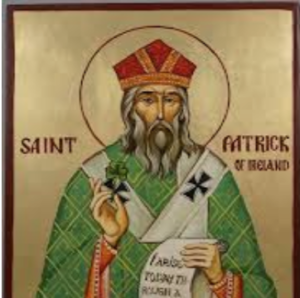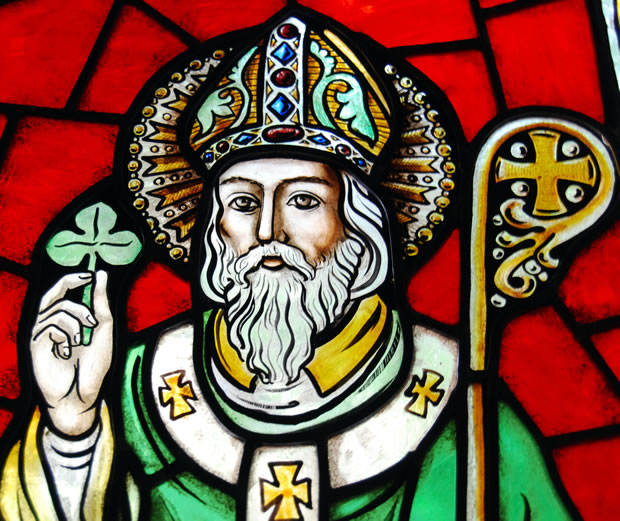Michelle Johnson | March 2, 2020
The calendar on my desk now says “March”. In addition to the promise of days that are warmer and daylight that extends beyond the dinner hour, there is a date (March 17) dedicated to Saint Patrick. Popular culture says it is a day to wear green, lay claim to an Irish heritage one might have and speak of things like luck and leprechauns. Where does the historic figure of Saint Patrick fit into this and what impact can he have on the church today?
 While legends and stories abound regarding Patrick’s life and ministry, there is relatively little information that comes from Patrick himself. There are only two writings that have come down to us from him. Late in his life, Patrick wrote a small book called “Confession.” This serves as both an autobiography as well as a defense for his work to spread the Gospel of Jesus in Ireland. Patrick was born in a village on the coast of Northern England in the latter part of the fourth century. His grandfather was a priest and his father a deacon in the church. Patrick admits as a teen, things of God weren’t of any real interest to him. His life changed as he approached his sixteenth year. Invaders from the island of Ireland arrived in England and took Patrick and many others captive.
While legends and stories abound regarding Patrick’s life and ministry, there is relatively little information that comes from Patrick himself. There are only two writings that have come down to us from him. Late in his life, Patrick wrote a small book called “Confession.” This serves as both an autobiography as well as a defense for his work to spread the Gospel of Jesus in Ireland. Patrick was born in a village on the coast of Northern England in the latter part of the fourth century. His grandfather was a priest and his father a deacon in the church. Patrick admits as a teen, things of God weren’t of any real interest to him. His life changed as he approached his sixteenth year. Invaders from the island of Ireland arrived in England and took Patrick and many others captive.
The next six years of young Patrick’s life was spent in Ireland as a slave. It was during this time, according to his book, God convicted Patrick of his sinfulness and his unbelief. Patrick was eventually able to escape his captivity. His escape came in the form of a ship that sailed away from Ireland. While on the journey away from Ireland, Patrick first became concerned for the salvation of others. He wanted those around him to know the truth of Jesus and the salvation that is available by believing in him.
The details of the middle years of Patrick’s life are unclear, it appears that he spent time both in England and on the continent of Europe. He was educated as a priest and returned to England to serve as such. In Confession, Patrick recounts a dream he had one night. This dream involved a visit from a man named Victorious who presented Patrick with letters from those in Ireland. The letter Patrick read requested that he return to Ireland and bring the Gospel with him. Patrick responded by returning to the land of his captivity. God had cultivated a heart in Patrick that longed to share the good news of Jesus with the very people who had enslaved him years earlier. Because of all God had done for him, Patrick said, “I cannot and ought not to be silent concerning the great benefits and graces which the Lord has bestowed upon me…”
Several centuries after his death, many began to write of this man known as Saint Patrick. The truth or falsity of such stories and tales is beyond the intent of this article. As the calendar has turned to March and the day set aside for Saint Patrick approaches, I hope to pause and consider the testimony of Patrick from his pen. As one can see, there is little of Patrick’s own story reflected in today’s celebration of St. Patrick’s Day – no shamrocks or leprechauns. He confessed a belief in the one true God of the Bible and acknowledged his only Son, Jesus as Lord. Patrick was convicted by God of his sinfulness and need for salvation. Patrick’s response was gratitude for God’s grace. God cultivated a concern within Patrick for those who were lost. It is Patrick’s testimony he devoted his life to telling others about the one true God, even those who had enslaved him.
Will we (the church and those that call themselves Christians) allow ourselves to be challenged by Patrick’s story? Do we truly care about the eternity of those around us? Will we pray for the opportunity not only to share Jesus with those we like and enjoy being with but also those who have wronged us? May we then respond and obey Jesus’s command to go and tell about all he has taught us – Matthew 28:18-20.
Sources:
Patrick, St., and James O’Leary. The Story of Saint Patrick: Patrick’s Confession with His Life and Acts (Illustrated). Kindle Edition., 2012.
About the Author
Michelle Johnson earned her M.A. in Theological Studies and her M.Div. in Professional Ministries at Liberty University, where she is also working on her Ph.D. in Theology and Apologetics. Michelle is also a graduate of the University of Minnesota. She and her husband Steve live in Mankato, Minnesota, where she also serves in women’s ministry. In addition to a love of theology, apologetics and church history, Michelle also has a passion for creationism studies. When she is not spending time reading or writing, Michelle can often be found dreaming of her next travel adventure or enjoying a great cup of coffee.






[…] Source: Shamrocks, Leprechauns and Saint Patrick […]